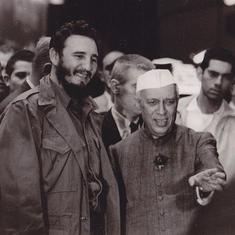Raag Lalita Gauri
On the first track, Kesarbai Kerkar sings the famous khayal Preetam sainyaan composed by the eighteenth-century composer Niamat Khan "Sadarang" in the late evening raag Lalita Gauri. Beginning with an expansive aalaap sung in a characteristic aakar using the vowel "aa", she later moves to slow taans called behalava. She nudges the melodic phrases, floating freely over the rhythmic canvas, but swooping on the mukhada or that part of the composition leading to the sam/sum or the first matra or time-unit of the time-cycle. In this case, the time-cycle or taal is the 16-matra Teentaal.
A good part of the performance is also devoted to fast taans that are sung in three octaves. Listeners will notice the clarity, precision and tunefulness in her taans, even when she executes the most difficult of melodic sections at great speed. The original speed is gradually increased through the recital.
The acknowledgements mention that the recording has been made in 1957 and features Farrukhabad gharana maestro Keramatullah Khan as the tabla accompanist.
Raag Malkauns
The magic of a live concert can never be captured in a studio recording. Naturally, the spontaneity of the moment depends upon the performers’ desire to be open to adventure and risks during their recital. Kesarbai Kerkar demonstrates this adequately on the next track. She sings a vilambit or slow khayal set to Teentaal in the night raag Malkauns.
This recital is quite different from the renditions that are otherwise available today. She has been accompanied by two sarangis, which in itself is unusual, as there was normally only one sarangi with khayal performances during the period that this concert must have been held. There were earlier instances of two sarangis accompanying women singer-dancers, but this was probably for melodic support to the thumri-dadra forms. Harmonium accompaniment can also be heard in the background. There is a playful competitiveness among the performers.
Kesarbai Kerkar starts with long sweeping vistaar or elaboration using the vowel ‘aa’ and then goes on to taans. Interestingly, she indulges in some amount of layakari or play with the rhythm using the words of the song-text, which is not characteristic of her recordings that are available today. She ends by speeding up the original tempo to drut laya. Usually, vocalists sing a separate composition in the faster tempo, but here, Kesarbai sings the same composition at a quick pace.










